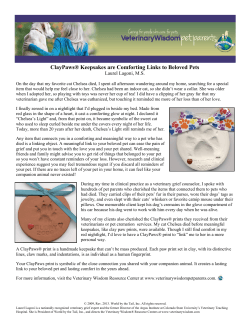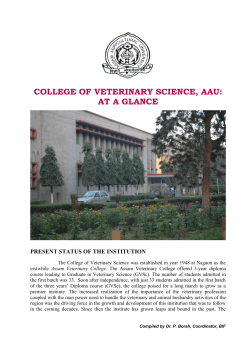
How to become a Veterinary Nurse in 10 Steps
How to become a Veterinary Nurse in 10 Steps 1: Gain work experience It is very important before you embark career in Veterinary Nursing to gain first hand experience in a variety of practices to be sure this is the profession for you, remember your role may vary a lot from practice to practice. This may be in a voluntary or paid capacity as a receptionist or similar role. 2: National Professional Veterinary Nursing Survey Before you consider Veterinary Nursing as a career it may interest you to look at the results of our National Professional Veterinary Nursing Survey which gives an overview of working conditions, salaries, daily tasks and attitudes of nurses currently working in the profession. 3: Decide where to study Veterinary Nursing The following table outlines Irish veterinary nursing courses that have been accredited or preaccredited by the Veterinary Council of Ireland. College Award NFQ Duration VCI status UCD BSc. (Hons) Level 8 4 years Accredited Athlone IT BSc. Level 7 3 years Accredited St. Johns Central College, Cork Advanced Certificate Level 6 2 years Accredited Dundalk IT BSc. Level 7 3 years Accredited Letterkenny IT BSc. Level 7 3 years Accredited Accredited courses have been successfully assessed by the Veterinary Council of Ireland as to course content and the competencies of graduates to perform veterinary nursing skills. 4:Apply to the appropriate college. Please follow the following weblinks to College courses. University College of Dublin http://www.ucd.ie/agandvet/veterinary nursing.htm Athlone Institute of Technology http://www.ait.ie/science/deptoflifephysicalscience/courses/caocourses/bachelorofscienceinve terinarynursing/ St Johns Central College http://www.stjohnscollege.ie/index.php?pageID=135 Dundalk Institute of Technology http://ww2.dkit.ie/schools_and_departments/nmha/applied_sciences/courses/dk784 Letterkenny Institute of Technology http://www.lyit.ie/courses/science/ly847/ 5: Join the IVNA Free membership for students http://www.ivna.ie/join-ivna.html 6: Register with the Veterinary Council of Ireland What is the Register of Veterinary Nurses? A. This is a list of Veterinary Nurses who have graduated successfully from a Veterinary Nursing course accredited by the VCI and who have signed the VCI register. This list is revised and republished annually. RVNs pay an annual fee to remain on the professional register. They must also prove that they are undergoing Continuing Veterinary Education (12 CVE credits annually) as detailed below. Who are Registered Veterinary Nurses (RVNs)? RVNs are Veterinary Nurses who have signed the register and made a declaration to the VCI, who have paid their fees and who have undergone appropriate CVE. Only RVNs are allowed to perform ‘Acts of Veterinary Nursing’ as described in the Veterinary Practice Act 2005 and must ensure annual registration in order to full fill their legal obligation and be permitted to work within the Republic of Ireland as a veterinary nurse. Only Registered Veterinary Nurses are permitted to call themselves Veterinary Nurses, and may use the post nominal’s ‘RVN’ after their name. If you wish to use additional post nominal’s for other veterinary related qualifications for example DipAVN (Surg) you may apply to do so at time of registration or after obtaining the qualification. What is the Provisional Register of Veterinary Nurses? This is a list of veterinary nurses who had not undertaken formal education in veterinary nursing up to Jan 1st 2008 but who had extensive experience within a veterinary practice. Provisionally Registered Veterinary Nurses must complete their formal education by 2012 in order to enter onto the Register of Veterinary Nurses. This one-year-course began in September 2010 and was only available to Provisionally Registered Nurses to enter. In 2012 the Provisional Register will cease to exist. What other Veterinary Nursing courses have been recognised by the VCI? In addition to graduates of the accredited courses listed above, the VCI recognise qualifications from: RCVS qualified veterinary nurses All other qualifications are assessed on a case by case basis. 7: Apply for a job Veterinary nursing jobs are normally advertised on the following two websites: www.ivna.ie http://www.veterinaryireland.ie You can always check that the practice you are applying to is a registered practice under the Practice Accreditation Scheme (PAS) as regulated by the Veterinary Council of Ireland (VCI) by logging onto their website: http://www.vci.ie/ 8:Work as a Veterinary Nurse See Part 8 Section 91 of The Veterinary Practice Act 2005 to see the procedures that only registered veterinary nurses are allowed to perform. http://www.irishstatutebook.ie/2005/en/act/pub/0022/sec0090.html#partviii 9: CVE credits Continuing Veterinary Education credits are credits allocated by the Veterinary Council of Ireland for Continuing Veterinary Education. This can also be referred to as C.P.D. or Continuing Professional Development and they are mandatory. In order to remain on the Register, RVNs must obtain 12 CVE credits per annum. RVNs start collecting CVE credits within approximately the first 12 months after graduating from an accredited Veterinary Nursing course and signing the register, graduates are NOT required to obtain CVE credits. The CVE year runs from August 1st to July 31st and the 12 credits must be collected during this timeframe (i.e. NOT the calendar year) e.g1: A student undergoing an accredited VN course graduates in June 2011 and signs onto the VCI Register of Veterinary Nurses. This RVN must start collecting CVE credits as from August 1st 2012. This CVE year will end on July 31st 2013, whereby credits must be submitted to the VCI in order to remain on the Register in 2014. eg2: A student undergoing an accredited VN course graduates in November 2011 and signs onto the VCI Register of Veterinary Nurses. This RVN must start collecting CVE credits from August 1st 2012, with this CVE year ending July 31st 2013 in order to remain on the Register in 2014. In order to remain on the Register in 2012, what must previously qualified RVNs do? RVNs can undergo one of two options: They must prove that 12 CVE credits were obtained during the period from August 1st 2010 to July 31st 2011 in order to remain on the 2012 Register. Alternatively they can prove that 36 CVE credits were obtained from August 1st 2008 to July 31st 2011. eg.3: A student undergoing an accredited VN course graduates in June 2007 and signs onto the VCI Register of Veterinary Nurses. This RVN can collect 36 CVE credits from either August 1st 2008 to July 31st 2011 OR 12 CVE credits from August 1st 2010 to July 31st 2011 in order to remain on the Register in 2012. How does an RVN obtain CVE credits? Credits can be obtained by various methods- please refer to the CPD Booklet Link (Veterinary Nurse CVE Credit Allocation Table) for details. How does an RVN ‘prove’ credits were obtained from conferences/ veterinary meetings? Attendance and sign in / out sheets are provided at Veterinary Conferences. Delegates of conferences must ensure that these sheets are filled out appropriately. These will be submitted to the VCI by the organisers of the conference as proof of your attendance. Other courses may produce a certificate of attendance which you may need to submit to the VCI to gain your CVE credits. All information must be filled out on your ‘Veterinary Nurse CVE Credits Submission Form’ which can be downloaded from CPD Activity Log Link. Ok, I am sure I have obtained my 12 CVE credits between August 1st 2010 and July 31st 2011. Now what do I do? Firstly download your Veterinary Nurse CVE Credits Submission Form and print it out. http://www.ivna.ie/cpd-veterinary-courses.html Fill in the details required. Post off your form, together with any substantiating evidence to the VCI ASAP before the end of the calendar year. Your CVE credit claims will be examined by the VCI and validated if legitimate. You will be asked to pay your VCI fees in January of the following calendar year and your details will remain on the newly published Register for Veterinary Nurses of that year. 10: Enjoy your career as a Veterinary Nurse!
© Copyright 2025










